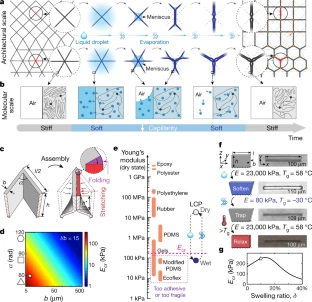Science Daily April 14, 2021
The fundamental topology of cellular structures can profoundly affect their acoustic, electrical, chemical, mechanical, and optical properties, as well as heat, fluid, and particle transport. In the previous techniques the resulting structures generally preserve the defining connectivity features of the initial topology. Researchers at Harvard University have developed a two-tiered dynamic strategy that achieves systematic reversible transformations of the fundamental topology of cellular microstructures, which can be applied to a wide range of materials and geometries. The approach requires exposing the structure to a selected liquid that can first infiltrate and plasticize the material at the molecular scale. As it evaporated it formed a network of localized capillary forces at the architectural scale that ‘zip’ the edges of the softened lattice into a new topological structure. It re-stiffens and remains kinetically trapped. They applied a mixture of liquids that act separately at the molecular and architectural scales to restore the original topology or provide access to intermediate modes. They demonstrated programmed reversible topological transformations of various lattice geometries and responsive materials that undergo fast global or localized deformations. They harnessed the technique to develop active surfaces with information encryption, selective particle trapping and bubble release, as well as tunable mechanical, chemical, and acoustic properties…read more. TECHNICAL ARTICLE

Strategy for topological transformation of cellular structures. Credit: Nature volume 592, pages386–391(2021)
CAPTION